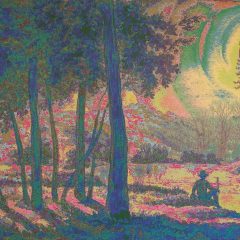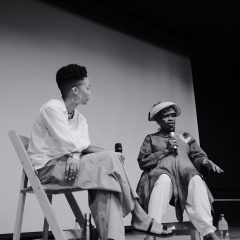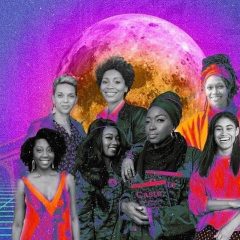As you walk into the slightly darkened Leonard Pearlstein Gallery, taking in the video exhibition, Lossless you are confronted by works by seven artists that are bold, imaginative, thoughtful and at times poignant, even a little didactic. For the most part, these films, videos and video installations, which were organized as part of the BlackStar Film Festival, are experimental and relate to the show’s theme of absence and identity of the Black/Brown body.
“Lossless” is a term used in the film world that references a film’s audio production process to compress the data without losing any of the original quality. According to the show’s curator and Artistic Director of BlackStar, Maori Karmael Holmes, the term within the context of the exhibit is used “to discuss absence in stories of trauma and nostalgia and….manifestations of resistance.” Lossless, the exhibit, delves into the reconstruction of Black/Brown bodies as they are imagined in relationship to labor, lineage and personhood, encompassing and releasing the restrictions enacted upon them by society, to paraphrase Maori Holmes.
From Sierra Leone to London in Kahlil Joseph’s “Process”
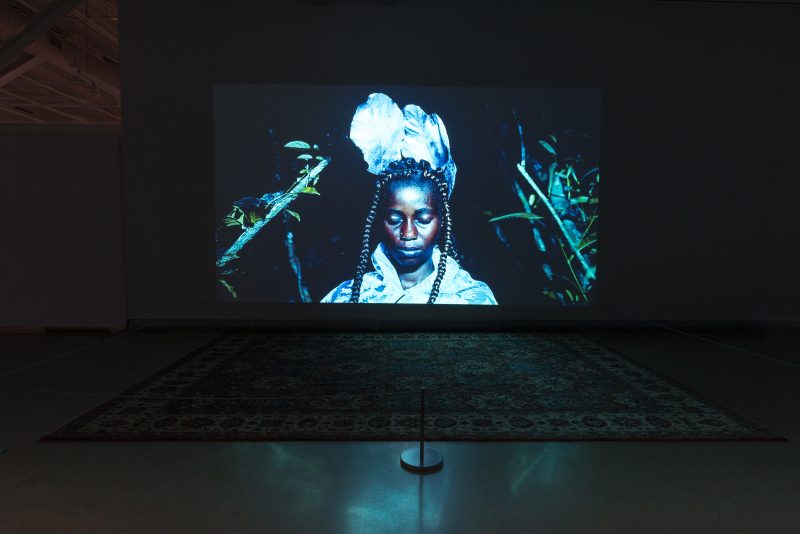
Kahlil Joseph’s “Process” creates a kaleidoscopic film based on the life and work of British songwriter/pianist/vocalist Sampha as he traces his ancestry from Sierra Leone to England. Sampha’s parents fled Sierra Leone in the 1980s prior to a civil war that devastated the country.
The film opens with a montage of Sierra Leone: women carrying baskets on their heads walking with a sway that is particular to women in Africa and the Caribbean; swimmers at the ocean’s edge; and young Muslims praying all wearing white kufi caps. Next the video segues to scenes of Sampha’s row home in the densely-populated Morden section of London, England. Joseph’s cinematic skills are on full display in the production of “Process.” He uses dancers from the National Dance Troupe of Sierra Leone in intermittent scenes as well as contemporary hip hop dancers. All this footage blends with the music of Sampha which is forlorn at times and magical. Joseph was featured in the 2014 ICA show Ruffneck Constructivists curated by Kara Walker.
Birth, Death and Ancestry in Roni Nicole Henderson’s “Mother’s Return”
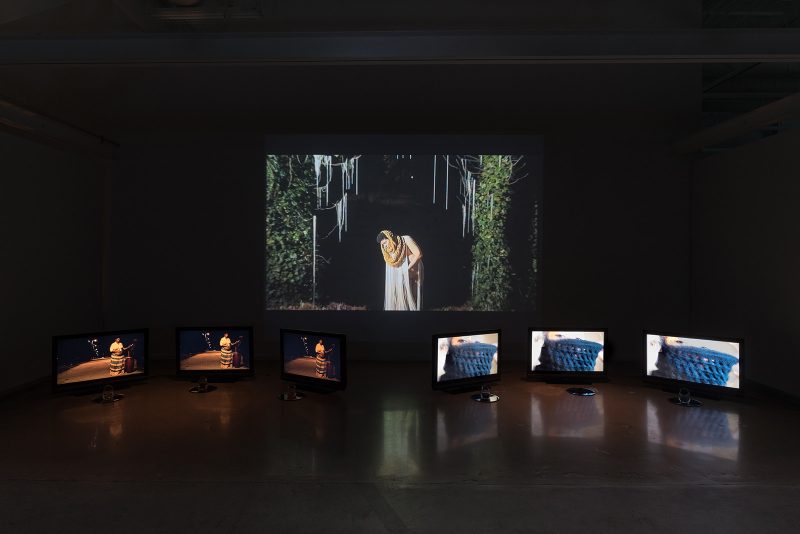
Incorporating an installation of votive candles with her video, Roni Nicole Henderson’s “Mother’s Return” uses ritual to explore the themes of birth, death and ancestral worship. Henderson is the central figure in this film; she is pregnant at the time of filming and is unapologetic about her protruding belly and accentuates that fact in the costumes she dons for several segments of this three-part work. In one section of the films she wears a striated cut white dress that reveals her voluptuous frame; in the other she dances in the street illuminated by street lights with a male companion whose movements she responds to with her own languid dance. There is a drum in this segment that serves as a prop; yet also evokes the idea of ancestral ties. Drums in Africa literally call the dancer to move; a drummer knows how to speak to the dancer through rhythms.
The black male body and society’s unrelenting lack of acknowledgement of the humanness and value of black lives in general is addressed in “Blackout: John Burris Speaks” by Terrance Nance. Nance uses the words of John Burris, a Civil Rights attorney, to punctuate the need to preserve black lives and “to do something!” Dance, gesture and movement by a troupe of black men articulate the narrative set by Burris. His words are instructional, didactic as he cites how to handle and interact with the police to stay alive. The film also is a promotional for the use of the economic power within the purview of black communities by not shopping on “Black Friday” after Thanksgiving. “Blackout” serves as a platform to instruct through mixed means on the need to remember the lives lost at the hands of the police. It teaches about preserving black lives and about the need of the Black community to send a message to America by using its economic power as a tool of protest.
“Three Quarters” by Kevin Jerome Everson explores the acumen of several black magicians i.e. “black magic”as they demonstrate the illusions of the trade. The film is like a ditty you can’t get out of your mind; shot in black and white, it possesses a timelessness.
Sosena Solomon’s installation and video “ITIFWORQ/Double Gold”
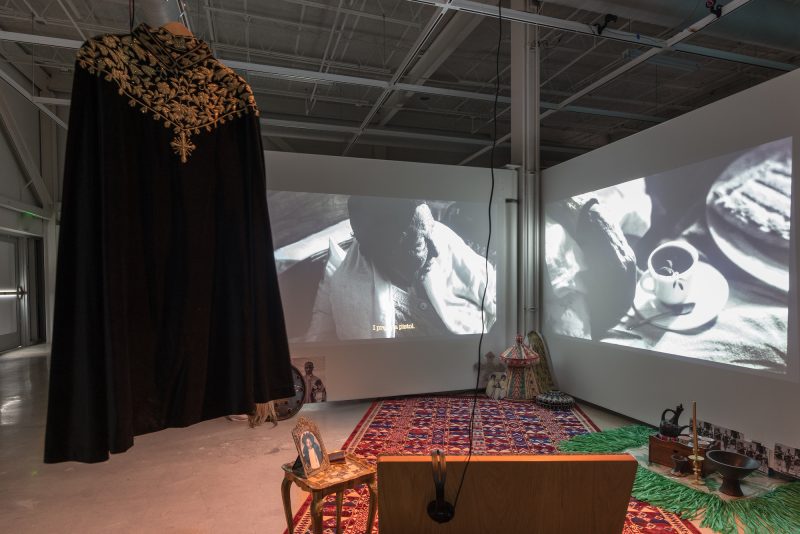
“ITIFWORQ/Double Gold” is a split screen installation by Sosena Solomon. Solomon films her grandmother, Itifworq, as she recounts her youth and role as a guerrilla fighter during the Italian occupation of Ethiopia in 1935. This is an emotional and touching docu-memoir filmed in black and white. Solomon captures intimate moments as Itifworq speaks of her youth and early marriages in a carefree frank manner even injecting humor and wit. Itifworq is the family’s 94 year old matriarch.
Razan Al Salah takes the viewer on an expedition through her homeland in Palestine through the use of Google maps. In her video, Your “Father Was Born 100 Years Old,” she traces the streets where her deceased grandmother may have lived and her father played in his youth. She speaks through the imagined voice of her grandmother in identifying how the streets of Palestine have changed and been renamed, such as William Stanton Street, named after a British colonel, now called Shivat Tsiyon Street, which means liberation in Hebrew. With this and other examples she ironically points out the exchange of one colonial power (England) for another (Israel). “Nakba” was the displacement of hundreds of thousands of Palestinians in order to create the Israel nation after World War II. The plan to repartition Palestine was developed by the newly formed United Nation dividing Mandate Palestine into Jewish/Arab states with 55% of the land given to the Jewish state. Refugee Palestinians to this day are denied rights to return to their homeland. Al Salah creatively seeks out a mode of travel via maps and cinema to reconstruct a journey she in reality cannot make.
An Ecstatic Experience exemplifies the role a belief system played in the liberation of the minds and souls of black folk. Ja’Tovia Gary appropriates footage from a 1964 television series entitled “History of the Negro People” and through a myriad of marks and forms animates the visage of the actress Ruby Dee as she enacts the slave narrative of Fannie Moore. How can you go wrong using a monologue performed by Ruby Dee to convey the power of a life liberated through divine intervention.
Through mixed means and cinematic devices as tools to tell stories and address issues pertaining to varying states of the black experience, this presentation is cohesive in its overall impact. And the use of large-scale projections in place of smaller video monitors works well in the gallery setting, To experience the entire program takes approximately one hour of your time to digest the full impact of the works. Needless to say, film and video are powerful instruments in the hands of these filmmakers.
LOSSLESS, through September 8, Leonard Pearlstein Gallery, 3401 Filbert Street.
M. Weaver resides in Philadelphia and is currently the Guest Curator for the exhibit “Gardens of the Mind: Echoes of the Feminine View” at AAMP.


